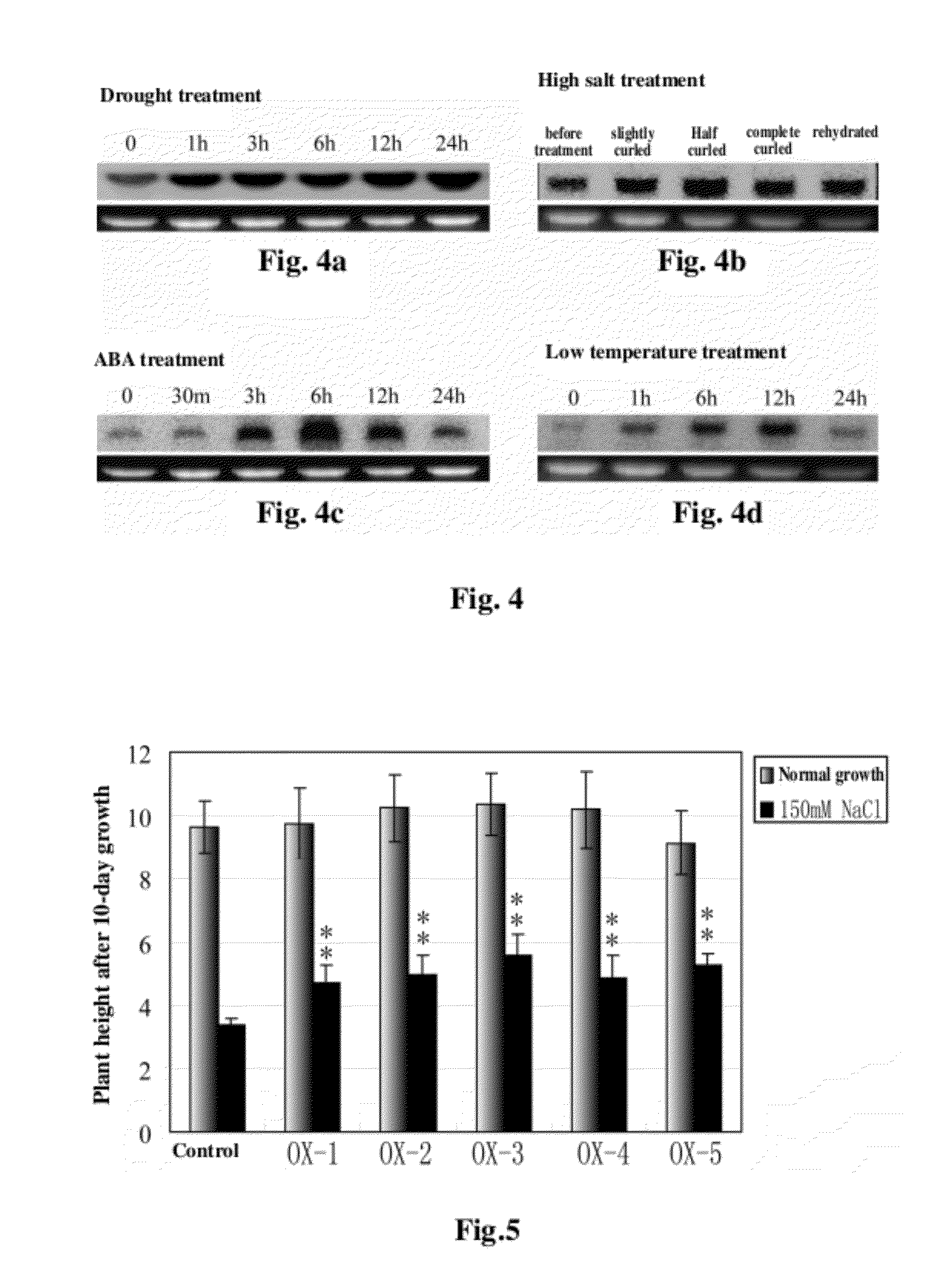Enhancing Salt Tolerance of Plants with Rice OsNHAD Gene
a technology of rice osnhad and salt tolerance, applied in the field of rice genetic engineering, can solve the problems of limiting the distribution of plants, affecting the growth of plants, and being susceptible to a wide variety of environmental factors, and achieve the effect of increasing the tolerance to non-biological stresses
- Summary
- Abstract
- Description
- Claims
- Application Information
AI Technical Summary
Benefits of technology
Problems solved by technology
Method used
Image
Examples
example 1
Isolation and Cloning of OsNHAD Gene
[0026]Through analysis of the expression profiles of drought inducible genes of the rice variety “Zhonghan 5” (a publicly used rice variety available from Shanghai Academy of Agricultural Sciences, China) and “Zhenshan 97” (a widely used parent for hybrid rice production in China), an EST (expression sequence tag) whose expression was upregulated when induced by drought was found. Sequence analysis on the product encoded by this OsNHAD gene indicated it had 71% homology to NHAD (a protein from soybean Rhizobium) (FIG. 1). The gene's corresponding cDNA clone J013023H14 was found by searching Knowledged-based Oryza Molecular Biological Encyclopedia of Japan (http: / / cdna( )1.dna.affrc.go.jp), and mapped to 110206 bp to 122237 bp of BAC clone AP005787 on chromosome 9. Total RNA was extracted from leaves of the drought-treated rice variety “Nipponbare” (a published rice variety) using TRIZOL reagent (Invitrogen Corp., performed according to the manufac...
example 2
Construction and Genetic Transformation of OsNHAD Gene Overexpression Vector
[0027]In order to better analyze the function of OsNHAD gene, it was overexpressed in rice for studying its function by observing the phenotypes of transgenic plants.
[0028]The overexpression vector was constructed as follows. Firstly, the positive clone pGEM-OsNHAD plasmid obtained in Example 1 was amplified using primers ALLF (5′-GGG GAC AAG TTT GTA CAA AAA AGC AGG CTT AAT ACG ACT CAC TAT AGG G-3′) and ALLR (5′-GGG GAC CAC TTT GTA CAA GAA AGC TGG GTA TTT AGG TGA CAC TAT AG-3′) to obtain a DNA segment comprising full-length OsNHAD gene. The reaction conditions were: pre-denaturing at 94° C. for 3 min; 35 cycles of 94° C. for 30 sec, 50° C. for 30 sec, and 72° C. for 4 min; and extension at 72° C. for 10 min The DNA segment was constructed into pDONR207 vector (purchased from Invitrogen Corp.) via BP recombination reaction according to the manufacturer's instructions of Invitrogen recombination cloning kit. T...
example 3
Determination of the Expression Level of Rice Endogenous OsNHAD Gene
[0065]RNA was extracted from ten various tissues collected at different growth stages of the rice variety “Zhenshan 97” (Oryza sativa L. ssp. Indica, a rice variety popularized in China) to determine the expression level of OsNHAD gene by real-time PCR. The ten tissues collected were: 1) callus; 2) seed; 3) three-day-old shoot; 4) leaf and root at trefoil stage; 5) flag leaf; 6) stem; 7) young spike shorter than 5 cm; 8) extruded spike; 9) glume; and 10) endosperm. Total RNA was extracted with TRIZOL reagent (Invitrogen Corp., performed according to the manufacturer's instruction), and reverse transcribed into cDNA with reverse transcriptase SSII (Invitrogen Corp., performed according to the manufacturer's instruction) under the following conditions: 65° C. for 5 min, 42° C. for 120 min, and 70° C. for 10 min. Using the above reverse transcribed cDNA as template, and using primers 5′-GCACAAAATCTCCCTCTATCCC T-3′ and ...
PUM
| Property | Measurement | Unit |
|---|---|---|
| volume | aaaaa | aaaaa |
| volume | aaaaa | aaaaa |
| volume | aaaaa | aaaaa |
Abstract
Description
Claims
Application Information
 Login to View More
Login to View More - R&D
- Intellectual Property
- Life Sciences
- Materials
- Tech Scout
- Unparalleled Data Quality
- Higher Quality Content
- 60% Fewer Hallucinations
Browse by: Latest US Patents, China's latest patents, Technical Efficacy Thesaurus, Application Domain, Technology Topic, Popular Technical Reports.
© 2025 PatSnap. All rights reserved.Legal|Privacy policy|Modern Slavery Act Transparency Statement|Sitemap|About US| Contact US: help@patsnap.com



